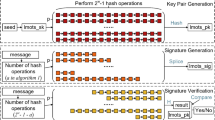Abstract
In this work, we introduce algorithms to speedup and to scale a classical secure multicast protocol that currently goes unused due to its computational and data management requirements when the audience becomes large. This is in spite of its agreeable cryptographic properties, which offers real applicability. A core component of such an algorithm is the well-known method to solve congruent systems, the Chinese remainder algorithm (CRA). This work presents the study, design and implementation of a software approach to the CRA on different parallel architectures. Special attention is placed on big integers, which affect method performance, given that the system is more secure as the modules become larger. This problem leads to the design of a new and more efficient method to address these issues in a scalable way. The results represent an enhancement in efficiency, performance and scalability when compared to existing alternatives.



Similar content being viewed by others
References
Lin KY, Krishna B, Krishna H (1994) Rings, fields, the Chinese remainder algorithm and an extension—Part I: theory. IEEE Trans Circuits Syst II Analog Digital Signal Process 41(10):641–655
Rosen KH (2011) Discrete mathematics and its applications, 7th edn. McGraw-Hill Higher Education. isbn: 978-0077431440
Wang Y (1998) New Chinese remainder algorithms. Conference record of the thirty-second asilomar conference on signals, systems and computers, vol 1. pp 165–171
Toyoshima H, Satoh K, Ariyama K (1996) High-speed hardware algorithms for Chinese remainder theorem. 1996 IEEE International Symposium on circuits and systems, ISCAS 96, connecting the World, vol 2. pp 265–268
Lai YP, Chang CC (2003) Parallel computational algorithms for generalized Chinese remainder theorem. Comput Electr Eng 29:801–811
Olagunju AO (2008) A computational exploration of the Chinese remainder theorem. J Appl Math Inf 26:307–316
Chang CC, Kuo Y T, Lai YP (2006) Parallel computation of residue number system. International Conference on computing and informatics, ICOCI 2006. pp 1–6
Zhu S, Jajodia S (2010) Scalable group key management for secure multicast: A taxonomy and new directions. In: Huang H, MacCallum D, Du D-Z (eds) Network security. Springer, Berlin, pp 57–75
Liu B, Zhang W, Jiang T (2004) A scalable key distribution scheme for conditional access system in digital pay-TV system. IEEE Consum Electron 50(2):632–637
Chiou G, Chen W (1989) Secure broadcasting using the secure lock. IEEE Trans Softw Eng 15(8):929–934
Kruus S, Macker JP (1998) Techniques and issues in multicast security. In: Proceedings of military communications conference, MILCOM. pp 1028–1032
Lin KY, Krishna B, Krishna H (1994) Rings, fields, the Chinese remainder theorem and an extension—Part II: applications to digital signal processing. IEEE Trans Circuits Syst II Analog Digital Signal Process 41:656–668
Li Y, Xiao L, Wang Z, Tian H (2011) High performance point-multiplication for conic curves cryptosystem based on standard NAF algorithm and Chinese remainder theorem. 2011 International Conference on information science and applications (ICISA), pp 1–8
Rabin MO (1980) Rabin probabilistic algorithm for testing primality. J Number Theory 2:128–138
Antequera N, Lopez-Ramos JA (2011) Remarks and countermeasures on a cryptoanalysis of a secure multicast protocol. In: Proceedings of 7th international conference on next generation web services practices, Salamanca 2011. pp 201–205
Zhu S, Jajodia S (2010) Scalable group key management for securemulticast: a taxonomy and new directions. In: Network security. pp 57–75
Chen H (2009) CRT-based high-speed parallel architecture for long BCH encoding. IEEE Trans Circuits Systems II Express Briefs 56(8):684–686
Toyoshima H, Satoh K, Ariyama K (1996) High-speed hardware algorithms for Chinese remainder theorem. In: 1996 IEEE international symposium on circuits and systems, vol 2. ISCAS ’96, Connecting the World. pp 265–268
Barnat J, Bauch P, Brim L, Ceska M (2010) Employing multiple CUDA devices to accelerate LTL model checking. 2010 IEEE 16th international conference on parallel and distributed systems(ICPADS), pp 259–266
Karunadasa NP (2009) Accelerating high performance applications with CUDA and MPI. In: 2009 International conference on industrial and informations system (ICIIS). pp 331–336
Manavski SA (2007) CUDA compatible GPU as an efficient hardware accelerator for AES cryptography. In: Signal Processing and Communications, ICSPC 2007. pp 65–68
Zhao Y, Huang Z, Chen B, Fang Y, Yan M, Yang Z (2010) Local acceleration in distributed geographic information processing with CUDA. 18th international conference on geoinformatics. pp 1–6
Chakrabarti G et al (2012) CUDA: compiling and optimizing for a GPU platform. Procedia Comput 9:1910–1919
Acknowledgments
The lead author was supported by Grant TIN2008-01117. The third author was supported by Grant FQM211 of Junta de Andalucía.
Author information
Authors and Affiliations
Corresponding author
Rights and permissions
About this article
Cite this article
Álvarez-Bermejo, J.A., Arrufat, J.M. & López-Ramos, J.A. A parallel algorithm for secure multicast. J Supercomput 71, 1803–1816 (2015). https://doi.org/10.1007/s11227-014-1336-1
Published:
Issue Date:
DOI: https://doi.org/10.1007/s11227-014-1336-1




